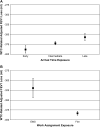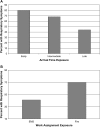Pulmonary function after exposure to the World Trade Center collapse in the New York City Fire Department
- PMID: 16645172
- PMCID: PMC2648115
- DOI: 10.1164/rccm.200511-1736OC
Pulmonary function after exposure to the World Trade Center collapse in the New York City Fire Department
Abstract
Rationale: On September 11, 2001, the World Trade Center collapse created an enormous urban disaster site with high levels of airborne pollutants. First responders, rescue and recovery workers, and residents have since reported respiratory symptoms and developed pulmonary function abnormalities.
Objectives: To quantify respiratory health effects of World Trade Center exposure in the New York City Fire Department.
Measurements: Longitudinal study of pulmonary function in 12,079 New York City Fire Department rescue workers employed on or before 09/11/2001. Between 01/01/1997 and 09/11/2002, 31,994 spirometries were obtained and the FEV(1) and FVC were analyzed for differences according to estimated World Trade Center exposure intensity. Adjusted average FEV(1) during the first year after 09/11/2001 was compared with the 5 yr before 09/11/2001. Median time between 09/11/2001 and a worker's first spirometry afterwards was 3 mo; 90% were assessed within 5 mo.
Main results: World Trade Center-exposed workers experienced a substantial reduction in adjusted average FEV(1) during the year after 09/11/2001 (372 ml; 95% confidence interval, 364-381 ml; p < 0.001) This exposure-related FEV(1) decrement equaled 12 yr of aging-related FEV(1) decline. Moreover, exposure intensity assessed by initial arrival time at the World Trade Center site correlated linearly with FEV(1) reduction in an exposure intensity-response gradient (p = 0.048). Respiratory symptoms also predicted a further FEV(1) decrease (p < 0.001). Similar findings were observed for adjusted average FVC.
Conclusions: World Trade Center exposure produced a substantial reduction in pulmonary function in New York City Fire Department rescue workers during the first year after 09/11/2001.
Figures




Comment in
-
The World Trade Center collapse: a continuing tragedy for lung health?Am J Respir Crit Care Med. 2006 Aug 1;174(3):235-6. doi: 10.1164/rccm.200605-636ED. Am J Respir Crit Care Med. 2006. PMID: 16864714 No abstract available.
References
-
- Lioy PJ, Weisel CP, Millette JR, Eisenreich S, Vallero D, Offenberg J, Buckley B, Turpin B, Zhong M, Cohen MD, et al. Characterization of the dust/smoke aerosol that settled east of the World Trade Center (WTC) in lower Manhattan after the collapse of the WTC 11 September 2001. Environ Health Perspect 2002;110:703–714. - PMC - PubMed
-
- Feldman DM, Baron SL, Bernard BP, Lushniak BD, Banauch G, Arcentales N, Kelly KJ, Prezant DJ. Symptoms, respirator use, and pulmonary function changes among New York City firefighters responding to the World Trade Center disaster. Chest 2004;125:1256–1264. - PubMed
-
- Lin S, Reibman J, Bowers JA, Hwang SA, Hoerning A, Gomez MI, Fitzgerald EF. Upper respiratory symptoms and other health effects among residents living near the World Trade Center site after September 11, 2001. Am J Epidemiol 2005;162:499–507. - PubMed
-
- Prezant DJ, Weiden M, Banauch GI, McGuinness G, Rom WN, Aldrich TK, Kelly KJ. Cough and bronchial responsiveness in firefighters at the World Trade Center site. N Engl J Med 2002;347:806–815. - PubMed
Publication types
MeSH terms
Substances
Grants and funding
LinkOut - more resources
Full Text Sources
Other Literature Sources
Medical

